

Extremely Powerful Magnetic Field Detected At Edge of Supermassive Black Hole. Cometary Globule CG4 (God's Hand) Imaged by VLT. The VLT Survey Telescope, the largest telescope designed to exclusively survey the skies in visible light, imaged cometary globule CG4 or God's Hand as it is also known.
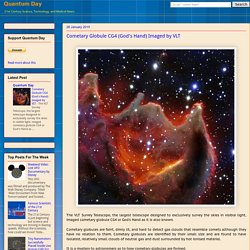
Cometary globules are faint, dimly lit, and hard to detect gas clouds that resemble comets although they have no relation to them. Cometary globules are identified by their small size and are found to have isolated, relatively small clouds of neutral gas and dust surrounded by hot ionised material. It is a mystery to astronomers as to how cometary globules are formed. God's Hand is 1300 light years from Earth and can be found in the constellation Puppis (The Poop, or Stern). CG4 gas a diameter if 1.5 light years and its tail is 8 light years long. This picture comes from the ESO Cosmic Gems programme, an outreach initiative to produce images of interesting, intriguing or visually attractive objects using ESO telescopes, for the purposes of education and public outreach. Video: God's Hand Imaged. Pulsar Disappears After Space-Time Warp Measured. Scientists have measured the space-time warp in the gravity of binary pulsar system J1906 and determined the mass of its neutron star before the pulsar vanished from view.
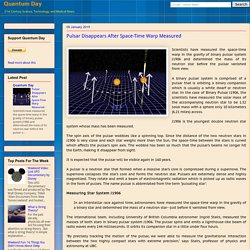
A binary pulsar system is comprised of a pulsar that is orbiting a binary companion which is usually a white dwarf or neutron star. Ongoing Assassin Project Has Detected 89 Supernovas To Date. Ohio State University reported that their All-Sky Automated Survey for Supernovae (ASAS-SN, pronounced "assassin") project has had tremendous success in detecting supernovas (supernovae).
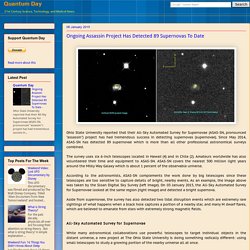
Since May 2014, ASAS-SN has detected 89 supernovae which is more than all other professional astronomical surveys combined. The survey uses six 6-inch telescopes located in Hawaii (4) and in Chile (2). Amateurs worldwide has also volunteered their time and equipment to ASAS-SN. ASAS-SN covers the nearest 500 million light years around the Milky Way Galaxy which is about 1 percent of the observable universe. According to the astronomists, ASAS-SN complements the work done by big telescopes since these telescopes are too sensitive to capture details of bright, nearby events.
All-Sky Automated Survey for Supernovae The strategy is paying off. Since it officially launched in May 2014, ASAS-SN has detected 89 bright supernovae and counting--more than all other professional astronomical surveys combined. European Extremely Large Telescope Groundbreaking in Cerro Armazones. The largest optical/infrared telescope in the world, the European Extremely Large Telescope (E-ELT), held its groundbreaking ceremony at the 3000 meter peak of Cerro Armazones in Chile.
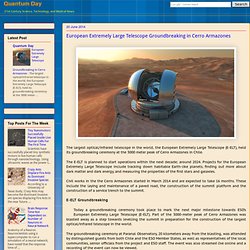
The E-ELT is planned to start operations within the next decade; around 2024. Projects for the European Extremely Large Telescope include tracking down habitable Earth-like planets, finding out more about dark matter and dark energy, and measuring the properties of the first stars and galaxies. Civil works in the the Cerro Armazones started in March 2014 and are expected to take 16 months. These include the laying and maintenance of a paved road, the construction of the summit platform and the construction of a service trench to the summit.E-ELT Groundbreaking Today a groundbreaking ceremony took place to mark the next major milestone towards ESO’s European Extremely Large Telescope (E-ELT). Probing the Secrets of Asteroid Itokawa.
Probing the Secrets of Asteroid Itokawa. Using the New Technology Telescope (NTT) by the European Southern Observatory, scientists have, for the first time, studied the internal structure of an asteroid.

The NTT studied the peanut shaped asteroid Itokawa. It helped scientists measure the asteroid's brightness variation as it rotates. Gravitational Waves Give Insight To Growth of Supermassive Black Holes. Scientists are looking at gravitational waves to understand the growth of supermassive black holes.
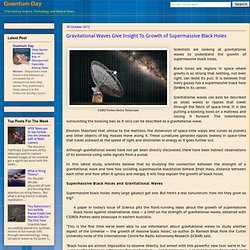
Black holes are regions in space where gravity is so strong that nothing, not even light, can resist its pull. It is believed that every galaxy has a supermassive black hole (SMBH) in its center. Gravitational waves can best be described as small waves or ripples that travel through the fabric of space-time. It is like putting a bowling bowl on a mattress and rolling it forward. The indentations surrounding the bowling ball as it rolls can be described as a gravitational wave.
Supermassive Black Hole at the Center of the Milky Way Rips Apart Giant Gas Cloud G2. The European Southern Observatory's Very Large Telescope (VLT)is observing a gas cloud (G2) being ripped apart as it passes the supermassive black hole at the center of the Milky Way galaxy.
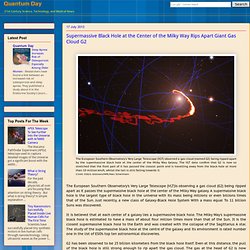
A supermassive black hole is the largest type of black hole in the universe with its mass being millions or even billions times that of the Sun. Just recently, a new class of Galaxy-Black Hole System With a mass equal To 11 billion Suns was discovered. It is believed that at each center of a galaxy lies a supermassive black hole. Coronal Mass Ejection Directed at the Earth Detected By NASA. NASA detected a coronal mass ejection from the Sun which may cause mild to moderate effects on instruments on Earth.
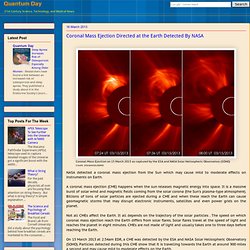
A coronal mass ejection (CME) happens when the sun releases magnetic energy into space. It is a massive burst of solar wind and magnetic fields coming from the solar corona (the Sun's plasma-type atmosphere). Billions of tons of solar particles are ejected during a CME and when these reach the Earth can cause geomagnetic storms that may disrupt electronic instruments, satellites and even power grids on the planet. Cosmic Rays Confirmed To Originate From Supernovas In Two Separate Announcements. In two separate announcements (and two separate studies), the European Southern Observatory and the Kavli Institute for Particle Astrophysics and Cosmology at the Department of Energy's (DOE) SLAC National Accelerator Laboratory confirmed that cosmic rays come from exploding stars or supernovas.

Cosmic rays are high energy particles from space. These particles travel at close to the speed of light and originate from outside the Solar System. They have very high energy that they can penetrate the Earth's atmosphere and even through solid rock at the surface. Prior to the announcement, its origin and how it was formed has been a mystery. Wired Science Presents Best Space Photos of 2012. For the past year, Wired has been featuring amazing and breathtaking photographs of space and everything in it.
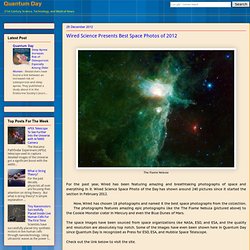
Wired Science Space Photo of the Day has shown around 240 pictures since it started the section in February 2012.Now, Wired has chosen 18 photographs and named it the best space photographs from the collection. The photographs features amazing epic photographs like the The Flame Nebula (pictured above) to the Cookie Monster crater in Mercury and even the Blue Dunes of Mars. The space images have been sourced from space organizations like NASA, ESO, and ESA, and the quality and resolution are absolutely top notch. Some of the images have even been shown here in Quantum Day since Quantum Day is recognized as Press for ESO, ESA, and Hubble Space Telescope. ESO Installs Supercomputer At ALMA Facility - The ALMA Correlator. One of the fastest supercomuter, the ALMA correlator, has been fully installed and tested at the ALMA astronomical facility in Chile. With over 134 million processors and performance up to 17 quadrillion operations per second, the ALMA correlator is one of the fastest supercomputers in existence today.
The Atacama Large Millimeter /submillimeter Array (ALMA) is a space telescope located on the Chajnantor plateau in the Chilean Andes. It has 66 high-precision antennas, spread over distances of up to 16 kilometres. The facility is partially operational and will be fully completed by March 2013. How Do Roots of Plants Grow In Outer Space With Zero Gravity? An experiment in the International Space Station was conducted to study the growth of plant roots in outer space in a zero gravity environment. The root is the organ of the plant that grows typically into the soil to extract water and minerals for the plant's nutritional need.
Roots grow depending on physical barriers, quality of the surrounding environment, and soil conditions. Some roots are aerial meaning that they rise above the ground. But most conventional root systems grown into the soil which aside from extracting nutrients, provides a stable anchor for the plant or tree to grow. Binary Stars Discovered Orbiting Center Of Fleming 1 Nebula By ESO's Very Large Telescope (VLT) The European Southern Observatory's Very Large Telescope (VLT) disovered a pair of stars orbiting each other at the center of the planetary nebula, Fleming 1. This discovery may explain the pattern Fleming 1 forms from its ejected gas. The research, “An Interacting Binary System Powers Precessing Outflows of an Evolved Star”, will appear in the journal Science. Planetary nebulae are bright glowing shells of gas around very dense Sun-like stars called white dwarfs.
This type of nebula has no relation or connection with planets at all. Planetary nebulae are named so because they resembled discs of the distant planets when seen through small telescopes. European Southern Observatory Releases New Image of Pencil Nebula. A Nebula (nebulae) used to refer to any extended astronomical object. The term even referred to galaxies like the Andromeda Galaxy which used to be called the Andromeda Nebula. The term now refers to an interstellar cloud of dust, hydrogen, helium and other ionized gases. These regions are usually were stars are formed or made as the materials present in the nebula start to amass together getting larger and larger until they become massive enough to form a star. Some of the materials present in the nebula can also form planets and other astronomical object. Galaxies and star clusters are now considered different from a nebula which can be generally termed as a gas cloud in space.
Quantum Day : ESO News: Launch of UNESCO–IAU Astronomical Heritage Web Portal. Buildings and monuments relating to astronomy throughout the ages stand as a tribute to the diverse and often complex ways in which people have rationalised the cosmos and framed their actions in accordance with their understanding of it. This includes, but is by no means restricted to, the development of modern science. The Reflection Nova Messier 78 and the Atacama Pathfinder Experiment telescope (APEX) The Atacama Pathfinder Experiment telescope (APEX) is a 12 meter diameter telescope.
James Webb Space Telescope Getting Ready To Launch and Replace The Hubble. The James Webb Space Telescope (JWST or simply Webb) is a large, infrared-optimized space telescope. Designed to replace the Hubble Space telescope, Webb is projected to launch into space in 2018. Its mission is to find the first galaxies that formed when the universe was young. ESO News: Two Contests To Commemorate 50th Anniversary of ESO - Choose What The VLT Observes Or Visit The VLT.
NASA Flight Surgeons - Ensuring the Health and Safety of Astronauts. Astronauts on space missions have lots of responsibility. They are tasked to work with million dollar equipment and do complicated scientific experiments. They have to make sure that they are alert and healthy facing the rigors of space. An astronaut cannot afford being sick during a space mission. When an astronaut faces health concerns, he or she may be reassigned somewhere else or even "grounded". Baryon Oscillation Spectroscopic Survey (BOSS) Studying and Observing the Accelerating and Expanding Universe. Since 1992, it has been suggested that the universe appears to be expanding at an increasing rate.